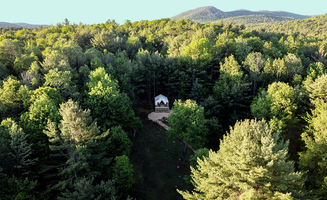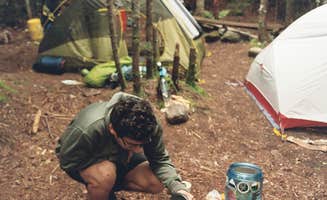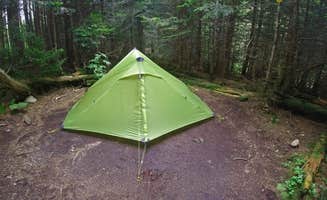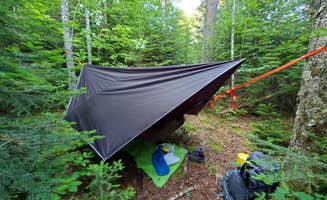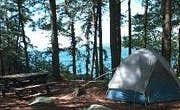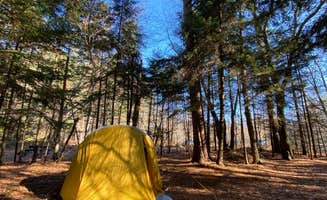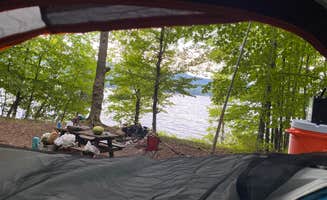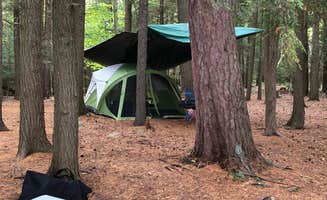Adirondack dispersed camping near Sabael, New York ranges from remote primitive sites requiring substantial hiking to more accessible shoreline camping areas along the region's lakes and ponds. Sites within the Adirondack Park typically sit at elevations between 1,600-2,000 feet, with seasonal temperatures fluctuating widely from summer highs near 80°F to fall lows dipping below freezing. Forest vegetation consists primarily of mixed hardwoods and conifers with birch, maple, and pine dominating the landscape around most tent campsites near Sabael.
What to do
Boat-accessed camping adventures: Visitors to Tioga Point Campground can only reach campsites by water transport across Raquette Lake. "The campsites are private and you can enjoy the beach with crystal clear water. Fishing is great," notes camper Lee W. This boat-in requirement creates seclusion from typical campground noise.
Lakeside swimming options: Several primitive tent sites offer direct water access from your campsite. "There is a large sand bar within a very short walk which was a great place to hang out," reports Mary B. about Seventh Lake Primitive Camping. Pack swimwear for warm weather stays as most sites lack formal beaches but provide natural shoreline access.
High peaks hiking access: Camp at several established sites that serve as basecamp for tackling Adirondack mountain trails. "The trail to Mt. Skylight and Mt. Marshall are both close enough to hike in the day. The campsite is also close to Lake Tear of the Clouds," explains Isabel D., who stayed at Flowed Lands. Most high peaks trails connect directly to backcountry campsites, eliminating driving between your tent and trailheads.
What campers like
Private island experiences: Boat-in sites create natural boundaries between campers. At Saranac Lake Islands Adirondack Preserve Campground, "There's something novelty about getting in a boat and paddling to your island for the week!" says Molly G. Many visitors appreciate having entire islands or peninsulas to themselves, providing rare privacy compared to traditional campgrounds.
Rustic lean-to shelter options: Throughout the region, three-sided wooden shelters offer alternative accommodation to standard tents. "We stayed at the Calamity Lean to for 3 nights on a school trip, and it was my favorite site we stayed at on the trip. The view of the lake is stunning," says Isabel about Flowed Lands. These structures typically accommodate 4-6 sleepers on wooden platforms.
Wildlife viewing opportunities: Campers regularly report loon sightings on lakes and occasional deer encounters near campsites. "Seventh lake is pretty quiet but there were a few boats there both days we visited," notes Mary B. Morning and evening hours provide best wildlife viewing conditions, with many campers reporting animal sightings directly from their tent sites.
What you should know
Bear-resistant container requirements: Bear canisters are mandatory equipment in many Adirondack camping areas. "Use bear bins- and clean up your camp. You'll save the Bears lives and you'll be happier!" advises Mike F. about Flowed Lands. Regulations specify approved container types, with rentals available at several outfitters in nearby towns for approximately $5-10 per day.
Limited water access: Many primitive sites lack potable water sources. At Cod Pond Dispersed Pull-Off, Taylor A. notes, "There is a river down the hill from the campsite which helps keep it fairly cool at night." Campers should plan to filter natural water sources or carry in drinking water for their stay.
Challenging access roads: Several camping areas feature rough entry roads requiring appropriate vehicles. "The road going in is very rough use extreme caution on a motorcycle with street tires," warns Max about Heart Lake access. Unpaved forest roads with potholes and occasional washouts are common throughout the region, especially after rainfall.
Tips for camping with families
Choose waterfront sites for built-in activities: Lakeside campsites provide constant entertainment for children through swimming, fishing, and shoreline exploration. "We jumped from the rocks and swam and played games," shares Molly G. about her experience at Saranac Lake Islands, where families typically spend most daylight hours engaged in water activities.
Consider lean-to options for easier setup: For families with younger children, Murphy Lake Leanto and similar shelters reduce equipment needs. "Once at the large Leanto, you will find a fire pit and ample room for many tents if needed," explains Tony F. These structures provide weather protection and simplified camping logistics for groups with children.
Pack extra layers year-round: Temperature fluctuations occur throughout the camping season, requiring preparation for potential cold snaps. "Bring warm clothing for nights; temps can drop 30 degrees in hours," advises Jerry M. about Saranac Lake Islands. Even summer overnight temperatures can dip into the 40s at higher elevations.
Tips for RVers
Limited RV access at most sites: Few primitive camping areas near Sabael accommodate recreational vehicles. Wilderness Campground at Heart Lake is one exception, though camper Laura Nicole A. cautions, "Beware of the roads coming in. 40MPH is too fast for these torn up roads." Most tent campsites near Sabael have vehicle restrictions or access limitations preventing RV entry.
Consider tow vehicle capabilities: Forest roads leading to many camping areas feature narrow passages and uneven surfaces requiring high-clearance vehicles. "A car is not recommended. Possible to turn around but you definitely need a smaller SUV," notes Taylor A. about Cod Pond's access conditions. Full-sized motorhomes and larger trailers cannot access most primitive sites in the region.
Prepare for no-hookup camping: Even at established campgrounds accepting RVs, hookups are limited or non-existent. Most primitive tent camping locations near Sabael offer no electricity, water, or waste connections, requiring self-contained camping capabilities for any RV visitors.



